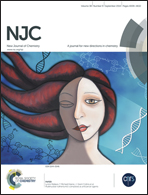Influence of ligand environment on the structure and properties of silver(i) dithiocarbamate cluster-based coordination polymers and dimers†
Abstract
Luminescent silver(I) homo- and heteroleptic pyridyl functionalised dithiocarbamate (dtc) complexes of the form, [{Ag(L)}4]∞ (L = N-benzyl-N-methylpyridyldtc (L1) 1, bis-(N-methylpyridyl)dtc (L2) 2) and [Ag(L)PPh3]2 (L = L1 (3), L2 (4)) have been synthesized and characterized by elemental analysis, TGA, spectroscopy (IR, 1H, 13C and 31P NMR and UV-Vis) and X-ray crystallography. Complexes 1 and 2 are isomorphous and have a tetranuclear cluster-based coordination polymeric structure. In these tetranuclear silver(I) cluster subunits the four Ag atoms form a distorted tetrahedron. Complexes 3 and 4 are also isostructural and have centrosymmetric structures in which each Ag atom forms a distorted tetrahedral coordination geometry. All complexes are weakly conducting and exhibit semiconductor behaviour. 1–4 are strongly luminescent in solid phase; a correlation between their structure and luminescent properties has been established.


 Please wait while we load your content...
Please wait while we load your content...